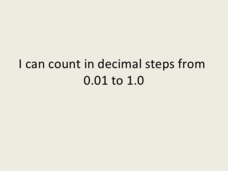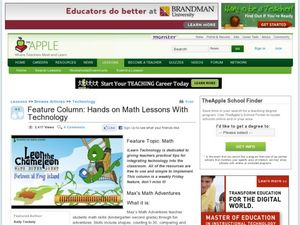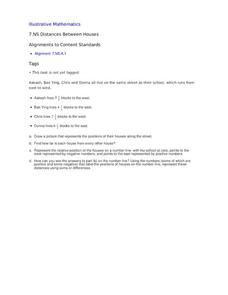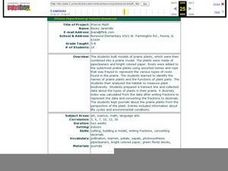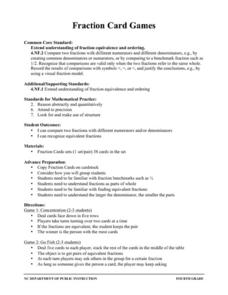Curated OER
Counting in Decimals
Learners use a complete decimal number chart starting with 0.01 and ending with 1.0. They then fill in missing decimals in a second chart and check their answers using chart 3. This idea is wonderful for getting kids to think about...
Curated OER
Feature column: Hands on Math With Technology
Young learners will view a math adventures video and practice math concepts. Afterwards they will navigate through Internet sites to participate in teacher selected math adventures. This guide walks you through integrating...
Curated OER
Distances Between Houses
This resource sneaks in the math so your learners will be adding and subtracting positive and negatives on a number line while thinking they are mapping out houses. The activity starts by putting houses the appropriate distance away from...
Curated OER
Krypto Math Game
Students play a math game. For this number sense and mental math lesson, students play a game where they use mental math to form equations that result in the target number required to win the game.
Curated OER
More on Rounding Whole Numbers
In this rounding worksheet, students solve 6 word problems where they must round numbers between 6 and 9 digits to the nearest thousand, ten-thousand, hundred-thousand, ten-million or hundred-million in order to arrive at a solution.
Curated OER
Reading, Writing, and Ordering Numbers
Pupils study place value. Students participate in place value and number relay games, write numbers in words, and discuss how numbers are read. As a class, they discuss the meaning of less than and grater than signs. Pupils use inverse...
Curated OER
Prairie Math
Students work together to build models of prairie plants. Using the model, they estimate the height and then measure them using metric and standard units. They write a fraction to represent their part of the whole set and compare and...
Curated OER
Number and Number Relations: Lesson 2
Fourth graders participate in using the terminology of more, less, between, compare, and order. They compare whole numbers and use the symbols for <, >, =. They order whole numbers and practice with problems where they use this...
Curated OER
Number and Number Relations: Lesson 3
Eighth graders compare whole numbers and decimals. They use symbols for <, >, =, and order whole numbers and decimals. They practice the meaning of positive and nugative integers by using them to describe real-world situations.
Curated OER
Ordering Negative Numbers
In this ordering negative numbers worksheet, students fill in missing whole numbers on a set of 4 number lines that include negative numbers. Answers included on page 2.
Curated OER
Order of Operations- One Digit Whole Numbers Math Worksheet
In this order of operations worksheets, students complete 20 problems with one digit whole numbers. They add, subtract, and multiply while following the rules for order of operations with and without parentheses.
Curated OER
Finding PI
Students select and use appropriate operations, methods and tools to compute or estimate using whole numbers. They develop and use formulas for determining the circumference and area of circles. Students determine and describe the...
Illustrative Mathematics
Counting Circles II
Fill those extra ten minutes of math time with this fun counting activity. Given a short sequence of numbers, young mathematicians stand in a circle and count one-by-one until the last number is reached, at which point the whole group...
North Carolina Department of Public Instruction
Fraction Card Games
Have fun with fractions in a math card game activity! Cut out the fraction cards and use them to reinforce fraction concepts, including common denominators, parts of a whole, and equivalent fractions.
Curated OER
Number Pairs
As you introduce graphs and coordinate pairs, use this guided activity to get scholars started. They reference an example before recording number pairs to identify the location of 12 letters on a grid. Next, learners examine shapes on a...
Curated OER
Location on a Grid
Make coordinate pairs more engaging by having beginners color-code a grid based on given locations. The grid has numbers along the y-axis and letters along the x-axis, introducing them to the ordering of coordinate pairs with the x-axis...
Curated OER
Number Pairs
This engaging coordinate pairs activity will have scholars intrigued; they mark 13 points on a grid and then connect them to create a capital block letter. Which one will it be? The grid has whole numbers 0-10 along both axes, so...
Curated OER
Number Pairs
As you introduce graphs to young scholars, use this coordinate pairs activity to give them some independent practice. Learners examine 12 points on a graph, all of which are in the first quadrant (and therefore positive). They write the...
For The Love of Teaching Math
Sink Cap’n K!
Turn a lesson on the coordinate plane into a class game of battleship with this fun math resource. Providing two coordinate grids and and places to fill in the ordered pairs that are guessed, this activity is a great way...
Curated OER
Find 2/3
This short problem with representing fractions on a number line is more than meets the eye. Labeled only with the numbers zero and 1/4, a number line is used to locate the fraction 2/3. A solution can be found in multiple ways, but young...
Curated OER
Location on a Grid
This grid features 15 animals, and scholars use a coordinate system to describe the location of each. The x-axis is labelled with letters and the y-axis with numbers, and they list the coordinate pairs beside the animal names below the...
Curated OER
Comparing Numbers
In this comparing numbers worksheet, students draw greater than or less than marks between pairs of numbers and order numbers from least to greatest. Students solve twenty-one problems.
Curated OER
Is Your Order Up or Down?
Students practice ordering numbers. In this number sense lesson, students collaborate to order whole numbers from greatest to least and least to greatest. Students also practice the concept by using educational software.
Helping with Math
Factors With Prime and Composite Numbers (1 of 2)
Math monsters examine nine numbers, factor them, and then determine if they are composite or prime. You can print this worksheet off of the website, but it does not fit neatly onto one page. Consider projecting it on your class screen...
